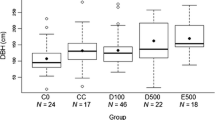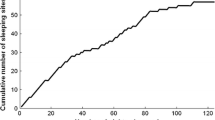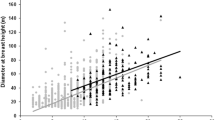Abstract
Multiple ecological factors have been hypothesized to influence primate sleeping site selection. Testing multiple hypotheses about sleeping site selection permits examination of the relative strength of distinct ecological factors and expands our ability to understand how selection pressures influence primate sleeping behavior. Here we examine how avoidance of biting insects, thermoregulation, foraging efficiency, tree stability, and interspecific competition influence selection of sleeping sites by proboscis monkeys (Nasalis larvatus) in Indonesian Borneo. We collected data on relative insect abundance, temperature, rainfall, food availability, group size, sleeping site location, and presence of other primates for 12 mo. Using formal model comparison and information criteria, we analyzed the relative importance of these ecological factors in determining one aspect of sleeping site location: distance from the river. Our models supported the avoidance of biting insects and the foraging efficiency hypotheses. Proboscis monkeys slept further inland on nights when the abundance of sandflies was high along the river, and when less food was available along the river. Many studies suggest that primates select sleeping trees and locations to reduce predation risk; our study indicates that additional factors may also be important in determining sleeping site selection.




Similar content being viewed by others
References
Albert, A., Savini, T., & Huynen, M. C. (2011). Sleeping site selection and presleep behavior in wild pigtailed macaques. American Journal of Primatology, 73(12), 1222–1230.
Anderson, J. R. (2000). Sleep-related behavioural adaptations in free-ranging anthropoid primates. Sleep Medicine Reviews, 4(4), 355–373.
Anderson, J. R., & McGrew, W. C. (1984). Guinea baboon (Papio papio) at a sleep site. American Journal of Primatology, 6(1), 1–14.
Barnett, A. A., Shaw, P., Spironello, W. R., MacLarnon, A., & Ross, C. (2012). Sleeping site selection by golden-backed uacaris, Cacajao melanocephalus ouakary (Pitheciidae), in Amazonian flooded forests. Primates, 53(3), 273–285.
Bennett, E. L., & Sebastian, A. C. (1988). Social organization and ecology of proboscis monkeys (Nasalis larvatus) in mixed coastal forest in Sarawak. International Journal of Primatology, 9(3), 233–255.
Bernard, H., Matsuda, I., Hanya, G., & Ahmad, A. H. (2011). Characteristics of night sleeping trees of proboscis monkeys (Nasalis larvatus) in Sabah, Malaysia. International Journal of Primatology, 32(1), 259–367.
Brotcorne, F., Maslarov, C., Wandia, I. N., Fuentes, A., Beudels-Jamar, R. C., & Huynen, M.-C. (2014). The role of anthropic, ecological, and social factors in sleeping site choice by long-tailed macaques (Macaca fascicularis). American Journal of Primatology, 76, 1140–1150.
Burnham, K. P., & Anderson, D. R. (2002). Model selection and multi-model inference: A practical information-theoretic approach. New York: Springer Science+Business Media.
Chapman, C. A., Chapman, L. J., & Mclaughlin, R. L. (1989). Multiple central place foraging by spider monkeys: travel consequences of using many sleeping sites. Oecologia, 79(4), 506–511.
Cheyne, S. M., Hoing, A., Rinear, J., & Sheeran, L. K. (2012). Sleeping site selection by agile gibbons: the influence of tree stability, fruit availability and predation risk. Folia Primatologica, 83(3–6), 299–311.
Cui, L. W., Quan, R. C., & Xiao, W. (2006). Sleeping sites of black-and-white snub-nosed monkeys (Rhinopithecus bieti) at Baima Snow Mountain, China. Journal of Zoology (London), 270(1), 192–198.
Dudley, R., & Milton, K. (1990). Parasite deterrence and the energetic costs of slapping in howler monkeys, Aloatta palliata. Journal of Mammalogy, 71(3), 463–465.
Feilen, K. L. (2014). Feeding ecology and sleeping site selection of proboscis monkeys (Nasalis larvatus) in West Kalimantan, Indonesia. University of California–Davis.
Feilen, K. L., & Marshall, A. J. (2014). Sleeping site selection by proboscis monkeys (Nasalis larvatus) in West Kalimantan, Indonesia. American Journal of Primatology. doi:10.1002/ajp.22298.
Freeland, W. J. (1977). Blood-sucking flies and primate polyspecific associations. Nature, 269(5631), 801–802.
Hamilton, W. (1982). Baboon sleeping site preferences and relationships to primate grouping patterns. American Journal of Primatology, 3, 41–53.
Hausfater, G., & Meade, B. J. (1982). Alteration of sleeping groves by yellow baboons Papio cynocephalus as a strategy for parasite avoidance. Primates, 23(2), 287–297.
Koops, K., McGrew, W. C., de Vries, H., & Matsuzawa, T. (2012). Nest-building by chimpanzees (Pan troglodytes verus) at Seringbara, Nimba Mountains: Antipredation, thermoregulation, and antivector hypotheses. International Journal of Primatology, 33(2), 356–380.
Krief, S., Levrero, F., Krief, J. M., Thanapongpichat, S., Imwong, M., et al. (2012). Investigations on anopheline mosquitoes close to the nest sites of chimpanzees subject to malaria infection in Ugandan Highlands. Malaria Journal, 11(116), doi:10.1186/1475-2875-11-116.
Lassen, S. B., Nielsen, S. A., & Kristensen, M. (2012). Identity and diversity of blood meal hosts of biting midges (Diptera: Ceratopogonidae: Culicoides Latreille) in Denmark. Parasites & Vectors, 5(1), 143.
Lutermann, H., Verburgt, L., & Rendigs, A. (2010). Resting and nesting in a small mammal: sleeping sites as a limiting resource for female grey mouse lemurs. Animal Behaviour, 79(6), 1211–1219.
Matsuda, I., Tuuga, A., Akiyama, Y., & Higashi, S. (2008). Selection of river crossing location and sleeping site by proboscis monkeys (Nasalis larvatus) in Sabah, Malaysia. American Journal of Primatology, 70(11), 1097–1101.
Matsuda, I., Tuuga, A., & Higashi, S. (2009). Ranging behavior of proboscis monkeys in a riverine forest with special reference to ranging in inland forest. International Journal of Primatology, 30(2), 313–325.
Matsuda, I., Tuuga, A., & Higashi, S. (2010). Effects of water level on sleeping-site selection and inter-group association in proboscis monkeys: why do they sleep alone inland on flooded days? Ecological Research, 25, 475–482.
Matsuda, I., Tuuga, A., & Bernard, H. (2011). Riverine refuging by proboscis monkeys (Nasalis larvatus) and sympatric primates: implications for adaptive benefits of the riverine habitat. Mammalian Biology, 76(2), 165–171.
Nakagawa, S., & Freckleton, R. P. (2011). Model averaging, missing data and multiple imputation: a case study for behavioural ecology. Behavioral Ecology and Sociobiology, 65(1), 103–116.
Nunn, C. L., & Heymann, E. W. (2005). Malaria infection and host behavior: a comparative study of neotropical primates. Behavioral Ecology and Sociobiology, 59, 30–37.
Ozbel, Y., Sanjoba, C., Alten, B., Asada, M., Depaquit, J., et al. (2011). Distribution and ecological aspects of sand fly (Diptera: Psychodidae) species in Sri Lanka. Journal of Vector Ecology, 36, S77–S86.
Phoonjampa, R., Koenig, A., Borries, C., Gale, G. A., & Savini, T. (2010). Selection of sleeping trees in pileated gibbons (Hylobates pileatus). American Journal of Primatology, 72(7), 617.
Prasetyo, D., Ancrenaz, M., Morrogh-Bernard, H. C., Utami Atmoko, S., Wich, S. A., & van Schaik, C. P. (2009). Nest building in orangutans. In Orangutans: Geographical variation in behavioral ecology (pp. 269–277). Oxford: Oxford University Press.
Ramakrishnan, U., & Coss, R. G. (2001). Strategies used by bonnet macaques (Macaca radiata) to reduce predation risk while sleeping. Primates, 42(3), 193–206.
R Development Core Team (2013). R: a language and environment for statistical computing. R Foundation for Statistical Computing, Vienna, Austria. http://www.R-project.org.
Salter, R. E., MacKenzie, N. A., Nightingale, N., Aken, K. M., & Chai, P. (1985). Habitat use, ranging behavior, and food habitat of the proboscis monkey, Nasalis larvatus (van Wurmb), in Sarawak. Primates, 26(4), 436–451.
Samson, D. R., Muehlenbein, M. P., & Hunt, K. D. (2013). Do chimpanzees (Pan troglodytes schweinfurthii) exhibit sleep related behaviors that minimize exposure to parasitic arthropods? A preliminary report on the possible anti-vector function of chimpanzee sleeping platforms. Primates, 54(1), 73–80.
Sebastian, A. C. (2000). Proboscis monkeys in Danau Sentarum National Park. Borneo Research Bulletin, 31, 359–371.
Smith, A. C., Knogge, C., Huck, M., Loettker, P., Buchanan-Smith, H. M., & Heyman, E. W. (2007). Long-term patterns of sleeping site use in wild saddleback (Saguinus fuscicollis) and mustached tamarins (S. mystax): Effects of foraging, thermoregulation, predation, and resource defense constraints. American Journal of Physical Anthropology, 134(3), 340–353.
Teichroeb, J. A., Holmes, T. D., & Sicotte, P. (2012). Use of sleeping trees by ursine colobus monkeys (Colobus vellerosus) demonstrates the importance of nearby food. Primates, 53(3), 287–296.
Thiry, V., Stark, D. J., Goossens, B., Slachmuylder, J. L., Vercauteren Drubbel, R., & Vercauteren, M. (2016). Use and selection of sleeping sites by proboscis monkeys, Nasalis larvatus, along the Kinabatangan River, Sabah, Malaysia. Folia Primatologica, 87(3), 180–196.
Tiwananthagorn, S., Bhutto, A. M., Baloch, J. H., Soomro, F. R., Kawamura, Y., et al. (2012). Zoophilic feeding behaviour of phlebotomine sand flies in the endemic areas of cutaneous leishmaniasis of Sindh Province, Pakistan. Parasitology Research, 111(1), 125–133.
van Buuren, S., & Groothuis-Oudshoorn, K. (2011). mice: Multivariate imputation by chained equations in R. Journal of Statistical Software, 45(3), 1–67.
van Schaik, C. P., van Amerongen, A., & van Noordwijk, M. A. (1996). Riverine refuging by wild Sumatran long-tailed macaques (Macaca fasicularis). In J. E. Fa & D. G. Lindburg (Eds.), Evolution and ecology of macaque societies (pp. 160–181). New York: Cambridge University Press.
Vasilakis, N., Hanley, K. A., Holmes, E. C., Weaver, S. C., & Cardosa, J. (2011). Fever from the forest: prospects for the continued emergence of sylvatic dengue virus and its impact on public health. Nature Reviews Microbiology, 9(7), 532–541.
Vythilingam, I., Tan, C., Asmad, M., Chan, S., Lee, K., & Singh, B. (2006). Natural transmission of Plasmodium knowlesi to humans by Anopheles latens in Sarawak, Malaysia. Transactions of the Royal Society of Tropical Medicine and Hygiene, 100(11), 1087–1088.
Whitten, A. J. (1982). The role of ants in selection of night trees by gibbons. Biotropica, 14(3), 237–238.
Xiang, Z., Xiao, W., & Huo, S. (2011). Selection of sleeping sites and sleeping trees by black-and-white snub-nosed monkeys (Rhinopithecus bieti) in Honglaxueshan National Nature Reserve, Tibet. Acta Theriologica Sinica, 31(4), 330–337.
Yeager, C. P. (1989). Feeding ecology of the proboscis monkey (Nasalis larvatus). International Journal of Primatology, 10(6), 497–530.
Yeager, C. P. (1991). Proboscis monkey (Nasalis larvatus) social organization: intergroup patterns of association. American Journal of Primatology, 23, 73–86.
Yeager, C. P. (1993). Ecological constrains on intergroup associations in the proboscis monkey (Nasalis larvatus). Tropical Biodiversity, 1(2), 89–100.
Acknowledgments
We thank the Indonesian government, the State Ministry of Research and Technology (RISTEK), and the mayor of Sungai Tolak for giving us permission to conduct this research. All work conformed to research regulations at the University of California, Davis and the laws of the Republic of Indonesia. We acknowledge the support and efforts of the Indonesian field assistants that worked on this project: Ferman, Iskandar and M. Ali. We thank Universitas Tanjungpura (UNTAN) and Flora and Fauna International–Indonesia for serving as our Indonesian counterparts for this project. This manuscript was greatly improved by thoughtful comments from Lynne Isbell, Ikki Matsuda, Vincent Nijman, Joanna Setchell, and an anonymous reviewer. Mark Grote provided invaluable assistance with statistical analysis. This research was funded by a U.S. Fulbright Student Fellowship, a Boren Fellowship, the University of California, Davis Department of Anthropology, and Primate Conservation, Inc.
Author information
Authors and Affiliations
Corresponding author
Ethics declarations
Conflict of Interest
The authors have no conflict of interest or competing financial interests to declare.
Additional information
Handling Editor: Joanna M. Setchell
Rights and permissions
About this article
Cite this article
Feilen, K.L., Marshall, A.J. Multiple Ecological Factors Influence the Location of Proboscis Monkey (Nasalis larvatus) Sleeping Sites in West Kalimantan, Indonesia. Int J Primatol 38, 448–465 (2017). https://doi.org/10.1007/s10764-017-9953-1
Received:
Accepted:
Published:
Issue Date:
DOI: https://doi.org/10.1007/s10764-017-9953-1




